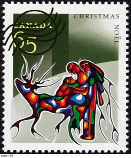Module 6
1. Module 6
1.7. Page 2
Module 6: Triangles and Other Polygons
Get Started
In this activity you will review proportional reasoning—an essential skill in solving problems involving similar polygons.
 Try This
Try This
Work with a partner, if possible.
TT 1. Angus is online looking for stamps to buy as a gift for his uncle, who is a keen collector. One stamp that has caught Angus’s attention is a 2002 issue celebrating First Nations and Inuit art.

© Canada Post Corporation (2002). Reproduced with permission.
Angus is wondering what the dimensions of the stamp are. The illustration says the stamp is 32 mm wide, but there is no mention of the stamp’s height. Angus knows the picture of the stamp online is similar to the actual stamp. Help Angus determine the height of the actual stamp.
Step 1: Print a copy of the 2002 “Aboriginal Art Christmas Stamp.”
Step 2: Measure the width and height of the stamp. Knowing that the width of the real stamp is 32 mm, use the dimensions of the stamp you printed to find the actual height of the stamp.
Step 3: Watch how Angus determined the height of the stamp in “Finding Stamp Height.”
Step 4: The method Angus used is an example of using a proportion—that is, a statement equating two ratios. Compare the method you used to answer this question with the method Angus used. Did you get the same stamp dimension Angus did?
 Self-Check
Self-Check
Use the method shown in TT 1 to solve each proportion. If you are working with a partner, do the questions independently, and then check each other’s work.
SC 1.
![]()
SC 2.
![]()
SC 3.
![]()
SC 4.
![]()